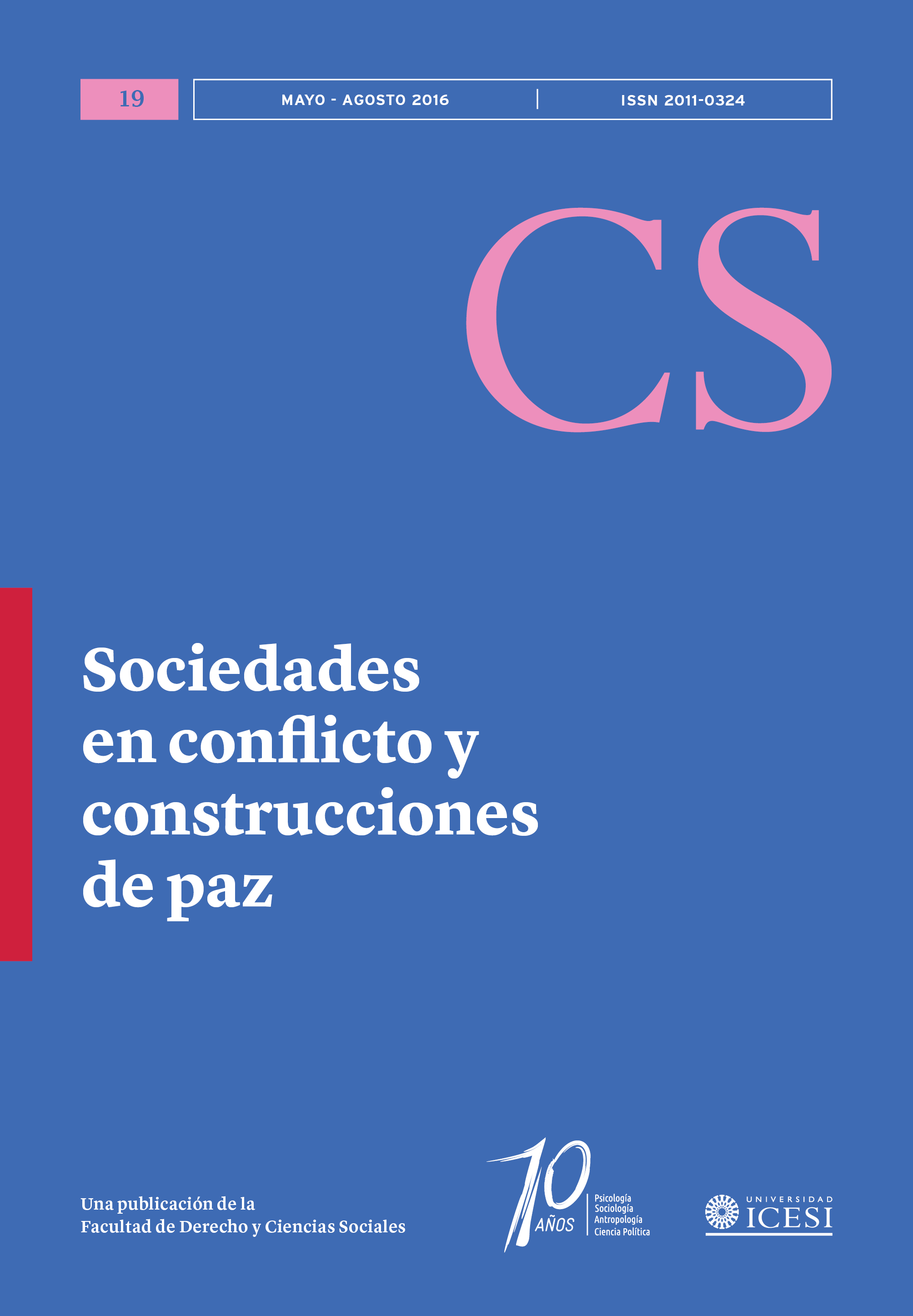Forums for consultation and follow-up of the peace agreements in Guatemala: lessons learnt for territorial peace in Colombia
DOI:
https://doi.org/10.18046/recs.i19.2141Keywords:
Civil society, Peace implementation, Infrastructure for peace, Guatemala, Territorial peace, ColombiaAbstract
This article considers the experience of the forums for consultation and the follow-up of the peace agreements in Guatemala and draws lessons for territorial peace in Colombia. Based on data from observation, interviews, and documents, it analyses how the consultation forums evolved into an infrastructure for peace, and the role they played in the decentralization of peace implementation. From this experience, It emphasizes the importance of the departmental level as a bridge between the grassroots and decision makers at the central level, and of the participation of traditionally marginalized groups for territorial peace. Additionally, the successful local peacebuilding initiatives that emerged during the war must be considered. It also discusses the role of multisectoral spaces in the peaceful transformation of local conflicts, and the need to maintain a balance between institutionalization and flexibility.Downloads
References
Acuerdo general para la terminación del conflicto y la construcción de una paz estable y duradera (2012). Firmado por el gobierno colombiano y las FARC el 26 de agosto de 2012 en La Habana. Recuperado de: https://www.mesadeconversaciones.com.co/sites/default/files/AcuerdoGeneralTerminacionConflicto.pdf
Acuerdo sobre aspectos socioeconómicos y situación agraria (1996). Firmado por el gobierno guatemalteco y la URNG el 6 de mayo de 1996 en México D.F. Recuperado de: http://old.congreso.gob.gt/Docs/PAZ/ACUERDO%20SOBRE%20ASPECTOS%20SOCIOECON%C3%–93MICOS%20Y%20SITUACI%C3%93N%20AGRARIA.pdf
Aguilar, I. (2002). ''La buena voluntad al servicio de la paz: La experiencia de la Mesa de Negociaciones para Conflictos de Tierra en Alta Verapaz, Guatemala''. En Y. A. Soto (Ed.), Nuevos caminos para la resolución de conflictos: experiencias latinoamericanas (pp. 107–140). Guatemala: Novedades.
Comisión de Esclarecimiento Histórico. (1999). ''Guatemala: Memoria del Silencio. Conclusiones y recomendaciones del Informe de la Comisión para el Esclarecimiento Histórico''. Guatemala: Comisión para el Esclarecimiento Histórico.
Decreto 11–2002, Ley de Consejos de Desarrollo Urbano y Rural (2002).
Chopra, T. (2009). ''When Peacebuilding Contradicts Statebuilding: Notes from the Arid Lands of Kenya''. International Peacekeeping, 16(4), 531–545. doi: 10.1080/13533310903184721
DANE. (s/f ). ''La visibilización estadística de los grupos étnicos colombianos''. Bogotá: Departamento Administrativo Nacional de Estadística.
Donais, T. (2009). ''Empowerment or Imposition? Dilemmas of Local Ownership in Post–Conflict Peacebuilding Processes''. Peace & Change, 4(1). doi: 10.1111/j.1468–0130.2009.00531.x
García, A., & Llinás , G. (2012). ''Los Programas de Desarrollo y Paz (PDP) de Colombia: una apuesta innovadora por el desarrollo y la paz en medio del conflicto armado''. In A. Rettberg (Ed.), Construcción de paz en Colombia (pp. 273–304). Bogotá: Universidad de los Andes.
García Durán, M., & Sarmiento, F. (2015). ''Demining in Micoahumado: from civil resistance to local negotiation with the ELN''. In S. Haspeslagh & Z. Yousuf (Eds.), Local engagement with armed groups: In the midst of violence. Accord Insight 2 (pp. 21–26). Londres: Conciliation Resources.
Ghebremskel, A., & Smith, R. (2013). ''Comments on Paul van Tongeren's 'Potential cornerstone of infrastructure for peace? How local peace committees can make a difference''. Peacebuilding, 1(1), 65–68.
Hernández, E. (2012). Intervenir antes de que anochezca: Mediaciones, intermediaciones y diplomacias no violentas de base social en el conflicto armado. Bogotá: La Bastilla.
Hernández, E. (2013). ''Mediaciones en el conflicto armado colombiano: hallazgos desde la investigación para la paz''. CONfines, 9(18), 33–57.
Hopp –Nishanka, U. (2012). ''Giving Peace an Address? Reflections on the Potential and Challenges of Creating Peace Infrastructures''. In B. Unger, S. Lundström, K. Planta & B. Austin (Eds.), Peace Infrastructures – Assessing Concept and Practice. Berghof Handbook Dialogue No.10. Berlin: Berghof Foundation.
Idler, A., Garrido , M. B., & Mouly, C. (2015). ''Peace Territories In Colombia: Comparing Civil Resistance In Two War–Torn Communities''. Journal of Peacebuilding & Development, 10(3), 1–15. doi: 10.1080/15423166.2015.1082437
Idler, A., Mouly, C., & Miranda, L. (2015). ''Power Unpacked: Domination, Empowerment and Participation in Local Guatemalan Peace Forums''. Peace, Conflict & Development (21), 1–40.
Jaramillo, S. (2014). ''La paz territorial''. Presentación en la Universidad de Harvard, Cambridge, MA, Estados Unidos, 13 de marzo.
Kaplan, O. (2013). ''Protecting civilians in civil war: The institution of the ATCC in Colombia''. Journal of Peace Research, 50(3), 351–367. doi: 10.1177/0022343313477884
Lederach, J. P. (1997). Building peace: sustainable reconciliation in divided societies. Washington, D.C.: United States Institute of Peace Press.
Lederach, J. P. (1999). ''Justpeace''. En European Centre for Conflict Prevention, in cooperation with IFOR & the Coexistence Initiative of the State of the World Forum (Eds.), People Building Peace: 35 Inspiring Stories from Around the World (pp. 27–36).
Lederach, J. P. (2008). La imaginación moral: el arte y alma de construir la paz. Bogotá: editorial Norma.
Lederach, J. P. (2013). ''The Origins and Evolution of Infrastructures for Peace: A Personal Reflection''. Journal of Peacebuilding & Development, 7(3), 8–13. doi: 10.1080/15423166.2013.767604
Masullo, J. (2015). The Power of Staying Put: Nonviolent Resistance against Armed Groups in Colombia. Washington D.C.: International Center on Nonviolent Conflict.
MDC de Jutiapa, MDC de Chimaltenango, MDC de Alta Verapaz, & MDC de Izabal. (2003). ''Estatutos de la Asamblea Nacional de Mesas de Concertación, ANAMEC; coordinadora nacional de mesas de concertación, CONAMEC y mesas departamentales de concertación, MDC y Seguimiento de los Acuerdos de Paz''. Izabal.
Mesas de Sacatepéquez, Quetzaltenango, Suchitepéquez, & El Progreso. (2001). ''Encuentro Nacional de Mesas Departamentales de Concertación y Seguimiento de los Acuerdos de Paz, La Antigua Guatemala''.
Mouly, C. (2004). The Role of Peace Constituencies in Building Peace in Nicaragua and Guatemala. Tesis de doctorado (PhD), Universidad de Cambridge, Cambridge.
Mouly, C. (2013). ''The Nicaraguan Peace Commissions: A Sustainable Bottom–Up Peace Infrastructure''. International Peacekeeping, 20(1). doi: 10.1080/13533312.2012.761833
Mouly, C., Garrido, M. B., & Idler, A. (2016). ''How Peace Takes Shape Locally: The Experience of Civil Resistance of Samaniego in Colombia''. Peace & Change, 41(2), 129–166. doi: 10.1111/pech.12184
Odendaal, A. (2010). ''An Architecture for Building Peace at the Local Level: A Comparative Study of Local Peace Committees'' Discussion paper. Nueva York: PNUD.
PNUD. (1998). Guatemala: Los Contrastes del Desarrollo Humano. Guatemala: PNUD.
Richmond, O. P. (2012). ''Missing Links: Peace Infrastructures and Peace Formation''. In B. Unger, S. Lundström, K. Planta & B. Austin (Eds.), Peace Infrastructures – Assessing Concept and Practice. Berghof Handbook Dialogue No.10. Berlin: Berghof Foundation.
Rojas, C. (2009). ''Women and peacebuilding in Colombia: resistance to war, creativity for peace''. In V. M. Bouvier (Ed.), Colombia: building peace in a time of war (pp. 207–224). Washington: United States Institute Peace Press.
Romero, M. (2015, 7 de febrero). Desafíos de la paz territorial. UNPeriódico, recuperado de: http://www.unperiodico.unal.edu.co/dper/article/desafios–de–la–paz–territorial.html
Ugarriza, J. E. & Nussio , E. (2016) ''The Effect of Perspective–Giving on Postconflict Reconciliation. An Experimental Approach'', Political Psychology,. doi: 10.1111/pops.12324.
Van Tongeren, P. (2013). ''Potential Cornerstone of Infrastructures for Peace? How Local Peace Committees Can Make a Difference''. Peacebuilding, 1(1), 39–60. doi: 10.1080/21647259.2013.756264
Downloads
Published
Issue
Section
License
Copyright (c) 2016 Cécile Mouly

This work is licensed under a Creative Commons Attribution-NonCommercial 4.0 International License.
© Reserved Copyright
Material in this publication may be reproduced without authorization, provided the title, author and institutional source is acknowledged.
The content published in Revista CS is distributed under the Creative Commons BY-NC 4.0 Attribution/Recognition-NonCommercial 4.0 International license.
You are free to:
Share — copy and redistribute the material in any medium or format.
Adapt — remix, transform, and build upon the material.
Under the following terms:
Attribution — You must give appropriate credit , provide a link to the license, and indicate if changes were made . You may do so in any reasonable manner, but not in any way that suggests the licensor endorses you or your use.
NonCommercial — You may not use the material for commercial purposes.












